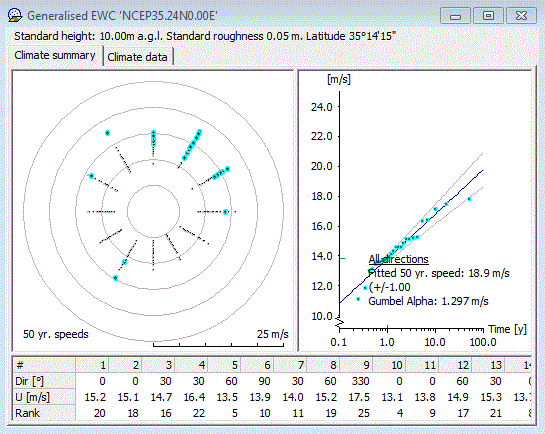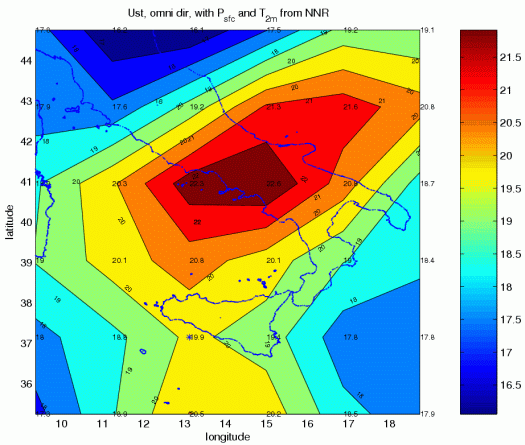Extreme wind atlas
Extreme Wind Atlas by reanalysis data
WAsP Engineering needs input for site-specific extreme-wind estimates. For this we generally recommend local measurements or representative data from not too distant meteorological stations. If the measurements are 10-minute averages the WAsP Climate Analyst can help you process the data and generate an observed extreme wind climate (OEWC) file.
WAsP Engineering can convert the OEWC to standard conditions (10 m above uniform flat terrain with 5 cm surface roughness length) and store the result in a regional extreme wind climate (REWC) file. In any case, the measurements should be of good quality and sufficient duration. The IEC 61400-1 standard suggests no less than seven years! Such data are not always available and as a substitute you might use data from the NCEP/NCAR reanalysis dataset.
Risø has developed a method based on geostrophic wind estimates using reanalysis surface-pressure data, see [1], [2] and [4] below. The effect of the disjunct sampling in the reanalysis data is compensated by a 13% correction [3] and the results are stored in REWC format. The method should be considered preliminary; it is not suitable for mountainous areas due to the way of calculating the geostrophic wind, it should be avoided in the equatorial regions because there is no geostrophic wind there, it is not accurate enough for areas where the extreme wind mechanisms are meso-scales, and it is not ideal for areas impacted by the tropical cyclones because of the coarse data resolution.
We are working on refinement of the method (1) through mesoscale modeling of individual storms using reanalysis data as boundary conditions only (2) by correcting both the spatial and temporal resolution effects [5].
Meanwhile you can download zip files with preliminary REWC files for Europe and the USA:
- Preliminary extreme wind atlas from Europe based on data from 1979 to 2004
- Preliminary extreme wind atlas from USA based on data from 1979 to 2005 (a format error was corrected 11/1-2007)
The file names indicate the latitude and longitude of the reanalysis data.
Note: The preliminary REWC files for Europe and the USA were made for use with WAsP Engineering 2, and therefore a 30 degrees discretization of wind direction data is applied. This rather rough discretization of wind direction data does not fully utilize the extreme wind climate treatment and modeling of regional and site-specific extreme winds in WAsP Engineering 3 (see here). However, the preliminary REWC files for Europe and the USA are applicable in WAsP Engineering 3, and should give more correct results as compared to WAsP Engineering 2.
References
-
Xiaoli Guo Larsén, Jakob Mann and Hans E. Jørgensen. Extreme winds and the connection to reanalysis data. Proceedings of the one-day conference on Extreme Winds and Developments in Modelling of Wind Storms, Cranfield University, 15th September 2004.
-
Jakob Mann, Xiaoli Guo Larsén and Hans E. Jørgensen. Regional Extreme Wind Climate and Local winds using WAsP Engineering. Proceedings of the one-day conference on Extreme Winds and Developments in Modelling of Wind Storms, Cranfield University, 15th September 2004.
-
Xiaoli Guo Larsén and Jakob Mann: Effects of disjunct stride and averaging time on maximum wind speeds. Journal of Wind Engineering and Industrial Aerodynamics, 2006, 94, 581-602.
-
Xiaoli Guo Larsén and Jakob Mann. Extreme winds from the NCEP/NCAR reanalysis data. Wind Energy, 2009. DOI: 10.1002/we.318, vol 12, p556-573.
-
Xiaoli Guo Larsén, Søren Ott., Jake Badger, Andrea N. Hahmann and Jacob Mann. Recipes for correcting the effect of mesoscale resolution on the estimation of extreme winds. Journal of applied meteorology and climatology, 2011. Published online, Doi: 10.1175/JAMC-D-11-090.1.


